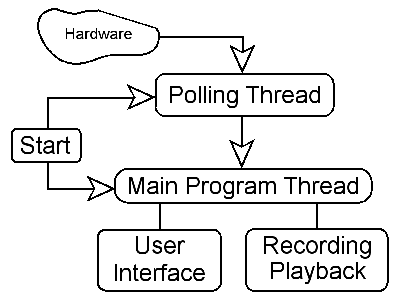How it works
The software is responsible
for a few things:
a. Clearing the hardware's
FIFO buffer.
b. Handling the user interface
for the fret buttons.
c. Recording the events
that might come at any time.
d. Playing the incoming
events, and replaying back the recorded events if requested.
"Multiple Tracks" recording
The program has functionality
to enable user to create a virtual music studio by recording different
tracks. Here's how you would do it:
- Set up the fret buttons according to your need. Remember that you can select what kind of instruments you want to use, including the percussions. Click record button. Play! When you're done, click stop button.
- Setup another settings for fret buttons, or just leave it like that if you just want to add some arrangements on the music. Click play button. Click record button. Play your music using this settings. Click stop when you're done.
- Repeat # 2 as necessary
First pass I played percussion "track" on it. Then second one I put some guitar arrangement on it. And the third one I put accoustic grand piano accompany on it. The playback wasn't bad at all except for the lousiness of Windows timer, some notes skipping could be noticed.
Unfortunately this capability was not shown very well during the expo due to number of people trying the guitar in real time only.
Note / Chord mode
To develop a full music
arrangement, most of the times we need to do more than one instruments.
And sometimes, we need to have chords instead of notes. Surely we can play
a chord by playing several notes, but if we need more efficient way of
playing chord we might just throw triplets and play them right away. The
program handled this possibility. In fact, in Note / Chord mode, you can
just drag and drop what kind of note, or possibily chord you want to associate
with the fret buttons. And you can always change what kind of instruments
you want to play it with.
Percussion mode
This mode implements MIDI
standard 10th channel percussion playback. To change the instruments you
want however, you must assign a note to it. You can click a button to show
what note is associated with a percussion instrument to make your life
easier.
Software Flowchart

Event Data Structure
| Name | Type | Explanation |
| mode | int | 0 = note, 1 = chord, 2 = percussion |
| tone | DWORD | value to send to MidiOutShortMsg() function |
| timestamp | int | time in ms starting from the "epoch". Epoch is reset each time recording started |
| chord_key | array[0..2] of DWORD | triplets DWORD values to send consecutively to midiOutShortMsg() function |
| instrument | int | what kind of instruments associated with this event |
Screenshot from the program (click
for full image)

Other stats
| Compiler used | Inprise Delphi 3.0 |
| Languages used | Pascal, C++, x86 Assembly |
| Code size (text) | 48 kB |
| Compiled code | 310 kB |